San Giovanni Profiamma
This small town is some 6 km north of Foligno. You can reach it from Foligno (Piazza Matteotti and the railway station) on weekdays using bus number 61.
Forum Flaminii
The modern town stands the site of the Roman settlement of Forum Flaminii, a trading post that developed in ca. 220 BC at the northern junction of the two branches of Via Flaminia. It became a municipium in ca. 90 BC and was probably connected for administrative purposes with nearby Fulginia (Foligno).
Nothing of its Roman past can be seen here today, although a number of archeological remains from the city are exhibited in the Museo Archeologico, Palazzo Trinci. The Emperor Trebonianus Gallus and his son Volusianus were defeated by Marcus Aemilius Aemilianus in a battle near Interamna Nahars. They fled and were murdered by their own guards at Forum Flaminii.
The Emperors Valentinianus, Theodosius and Arcadius issued an edict from “Foro Flamini” in the year of the consuls Timasius and Promotus (389 AD).
The church of San Giovanni Profiamma was built here before 1138.
Roman Remains
Fountain
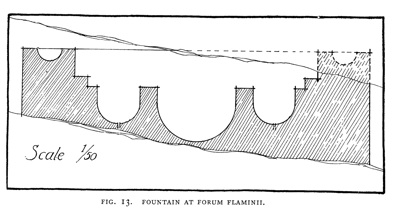
According to Ashby and Fell (referenced below, at p. 177):
-
“In 1911, excavations on the right edge of the ancient road [as one travels towards the Adriatic] ... brought to light the remains of a fountain in concrete, faced with bricks and small rectangular blocks of stone. As we have seen no record of them, we give a plan of what was visible [as Figure 13, illustrated above].”
Unfortunately, the precise location of the fountain is no longer known.
Head of Livia (14-31 AD)
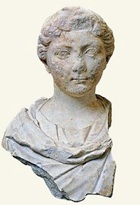
Inscription (1st century AD)
This inscription (CIL XI 7993), which was found during the excavation of 1832, is now in the Museo Archeologico. It reads:
[CES]IAE
[S]ABINAE
Inscriptions (3rd century AD)
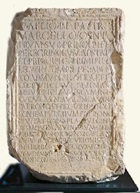
Early Christianity
According to the legend of St Felician (BHL 2846), he was born in Forum Flaminii. He studied in Rome and then returned “ad patriam”, which presumably meant to Forum Flaminii. He began to preach there, was elected as bishop and consecrated as such by Pope Victor I (189-99). As bishop, he first preached in ‘his city’, Fulginia and then successfully evangelised many other cities in Umbria. He held episcopal office for some 56 years but was arrested in 250 AD, during the persecution of Decius, while praying in basilica quae appellatur palatina (in the palatine basilica) at Forum Flaminii. Although he was now some 94 years old, he was taken in chains for interrogation in Rome:
-
✴he died en route at the ‘Mons Rotundum’, which was three Roman miles from ‘his city’ (which probably means Fulginia); and
-
✴he was buried in a cemetery near civitas Fulginia.
The legend of St Felician was probably written in ca. 850, so the contents above should probably not be taken literally. It is, nevertheless, significant that the writer clearly regarded Forum Flaminii as a credible candidate for the first episcopal centre in the vicinity.
The first documented bishop of Forum Flaminii is Bishop Boniface, who attended a synod in Rome in 502, alongside Bishop Fortunatus of Foligno. According to Silvestro Nessi (referenced below, at p. 861), the diocese of Forum Flaminii was absorbed by that Foligno later in the 5th century. If this is correct, then the diocese subsequently regained its independence: the only other early bishop known from documents is Bishop Decentius, who attended a synod in Rome in 679, together with Bishop Florus of Foligno.
Christian Basilica (6th century AD ?)
An early basilica was discovered 1929 some 100 meters from the church of San Giovanni Profiamma. Unfortunately, its exact location is unknown. It was only partially excavated, but a sketch made at that time records an apse and the start of a nave and two side aisles. According to Luigi Sensi (referenced below, at p. 9), it could be inferred from this sketch that the original structure was:
-
“... a large basilica made up of a tripartite longitudinal hall and a distinct apsed area” (my translation).
The iconography of a mosaic (below) discovered in situ reveals that this was an early Christian basilica. Luigi Sensi suggested (at p. 17) that this building might have been the source for the statement in the legend of St Felician (ca. 850 AD) that he had been arrested while praying in basilica quae appellatur palatina (in the palatine basilica).
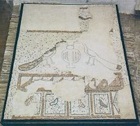
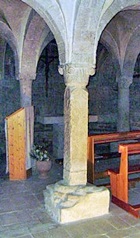
-
✴a peacock on one side;
-
✴a cross in a circle (above a geometrical pattern) on the second; and
-
✴a cross in a circle above a grape vine on the third.
According to Josselita Serra Raspi (referenced below, at 369-70 and Figures 3 and 5), the surviving fragment was perhaps half of an architrave used in a presbytery, in which the undecorated side would have faced upwards in a location in which it could not be seen. The motifs on the surviving half of the architrave would have been reflected symmetrically on the other half. She dated it to the middle of the 8th century. Luigi Sensi (referenced below, 1982, at p. 17) suggested that it might have been carved originally for this basilica.
Pale and Sassovivo
[I have not tried this hike, so please use what follows as a rough guide. I did my visits of Santa Maria di Giacobbe and Sassovivo separately by taxi.]
This hike from the sanctuary of Santa Maria di Giacobbe at Pale to the Abbazia di Sassovivo can be done on weekdays using the bus to get to the start: line 58 leaves Foligno station at 09:03 (as at June 2008) and arrives at Belfiore (the end of the route) at 09:25.
You can finish the walk after about 4 hours at Uppello: bus 57 leaves Uppello at 16:40 (as at June 2008) and arrives at Foligno, Porta Romana at 16:55.
Alternatively, you can walk into Foligno from Sassovivo (another hour) via the church and convent of San Bartolomeo di Marano (which you can alternatively visit as part of Walk III).
Colfiorito

If you are driving from Foligno, take SS 77 to Colfiorito (some 27 km) and continue a little way further to Hotel Lieta Sosta, at the junction with the SP 96 on the left. (If you take the bus from Foligno, alight at the Hotel Lieta Sosta):
-
✴The interesting Museo Archeologico Colfiorito is on the opposite side of the SP 96.
-
✴You can easily walk from here to Santa Maria di Plestia, which is about 1 km along the SP 96: this road traverses an the upland plateau that provided an important pass across the Apennines from the Valle Umbra to the Adriatic from an early date.
This is also the location of the lovely Parco Regionale di Colfiorito (although you will need a car to visit it).
Santa Maria di Plestia
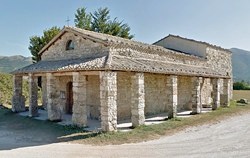
The church of Santa Maria di Plestia is found in what is now an isolated spot after just over 1 km along this road (exactly on the border between Umbria and the Marche). A bishop Florentius of Plestia attended synods held in Rome by Pope Symmachus in 499 and again in 502, and tradition has the present church standing on the site of the original Duomo. Plestia continued to be inhabited, and retained diocesan status into the 10th century..
Ancient History
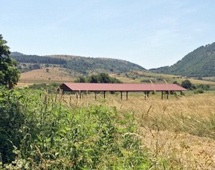
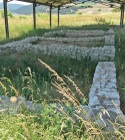
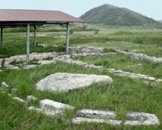
The church stands on the site of one of three known centres of habitation (10th-7th centuries BC) of the Plestini, an Umbrian tribe who lived across this upland plain: the other two were at:
-
✴località la Capannaccia, some 200 meters to the north of the church; and
-
✴località Fonte Formaccia,near the road to Taverne.
All three were on the shore of a lake known as the Lacus Plestinus.
The Plestini moved to a series of nearby hilltop sites in ca. 600 BC, the most important of which was on Monte Orve. The most important necropolis of the Plestini, between the foot of Monte Orve and the modern cemetery of Colfiorito, has yielded important evidence of their material culture. After the village at località Capannaccia ceased to be inhabited, it became the site of an important Umbrian sanctuary that was in use from the 6th to the 1st century BC. Four fragmentary Umbrian inscriptions that were found here revealed that it was dedicated to Cupra, who was claimed as the mother goddess of the Plestini.
The Roman centre of Plestia was established on the site of the church in the Republican period. The church itself stands on the site of a Roman building, and the area of the forum and the remains of a Roman domus have been excavated on the opposite side of the road to Taverne.
Museo Archeologico Colfiorito
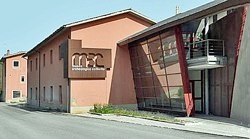
The Museo Archeologico Colfiorito is a modern museum that has a large collection of objects found in the Umbrian necropoles of the area and at the sanctuary of Cupra. It also has an interesting section devoted to Roman Plestia and to the church of Santa Maria di Plestia (above).
Read more:
E. Calandra, “Mosaico: Forum Flaminii”, in”
A. Bravi (Ed.), “Aurea Umbria: Una Regione dell’ Impero nell’ Era di Costantino”, Bollettino per i Beni Culturali dell’ Umbria, (2012) p. 84
S. Nessi, “La Diocesi di Spoleto tra Tardoantico e Medioevo”, in:
“Umbria Cristiana: dalla Diffusione del Culto al Culto dei Santi (secc. IV-X): Atti del XV Congresso Internazionale di Studi sull' Alto Medioevo (Spoleto, 23-28 Ottobre 2000)”, Spoleto (2001): pp 833-81
L. Sensi, “La Basilica Paleochristiana di Forum Flaminii”, Bollettino Storico della Città di Foligno, 5 (1982) 9-22
J. Serra Raspi, “La Scultura dell' Umbria Centro-Meridionale dall' VIII al X Secolo”, in:
“Aspetti dell' Umbria dall' Inizio del Secolo VIII alla Fine del Secolo XI: Atti del III Convegno di Studi Umbri, Gubbio, 23 - 27 Maggio, 1965”, (1966) Perugia, pp. 365-86
T. Ashby and R. A. L. Fell, “The Via Flaminia”, Journal of Roman Studies, 11 (1921) 125-90
Return to the page on Walks in Foligno.



